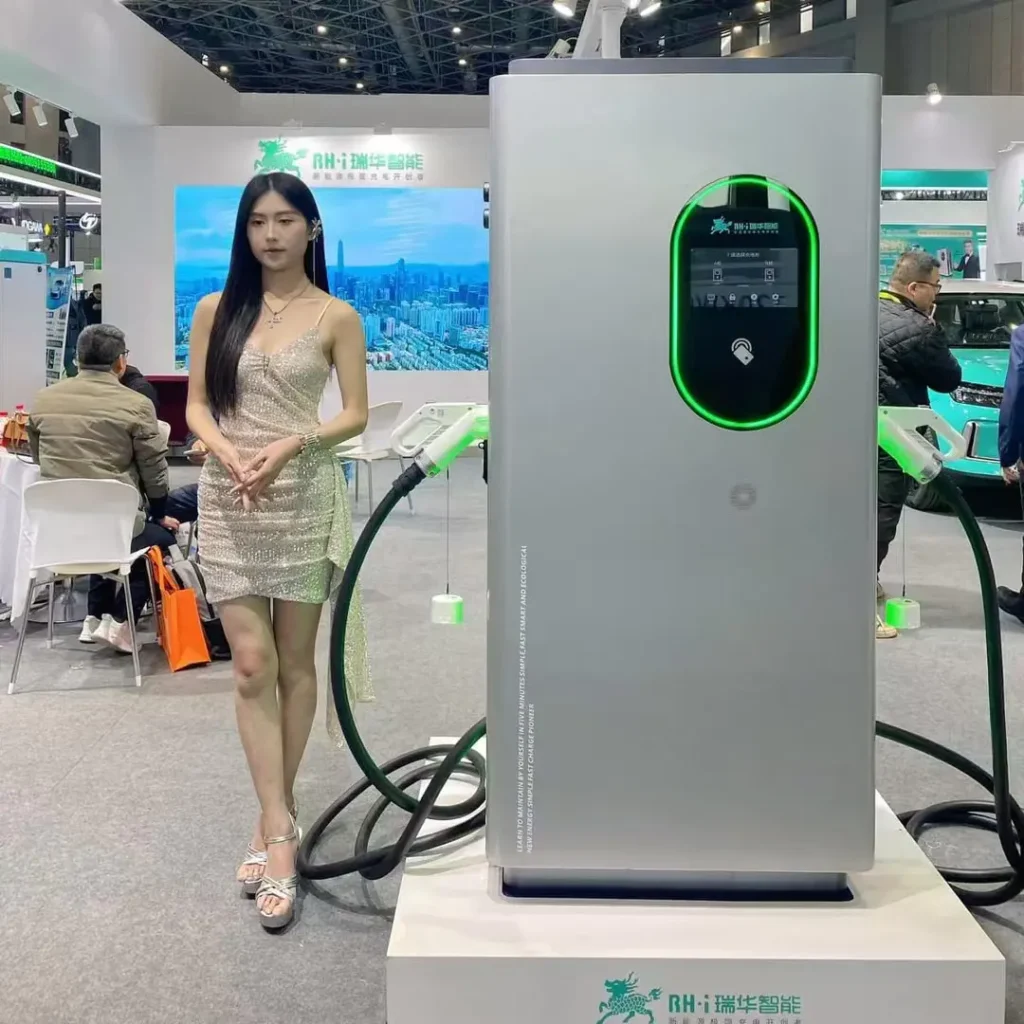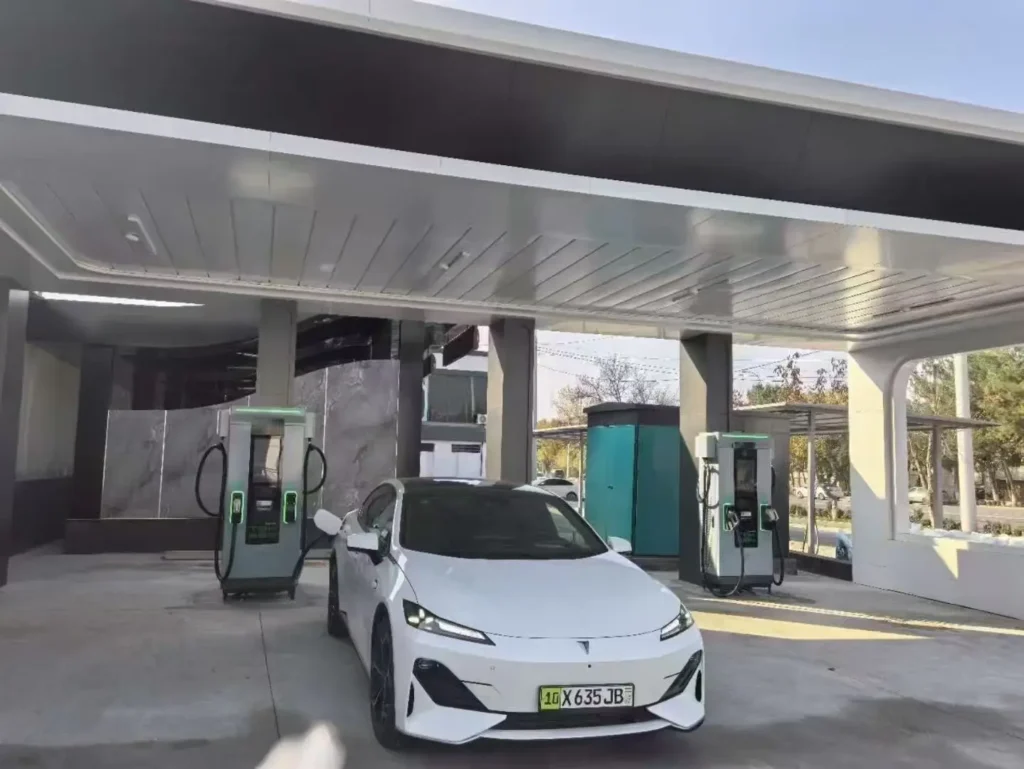Guide To Commercial EV Charging Station Installation & Cost
As electric vehicles become a cornerstone of modern transportation, installing EV chargers on commercial properties offers numerous benefits. Beyond supporting sustainability goals and boosting environmental, social, and governance (ESG) credentials, this move enhances customer and employee satisfaction while unlocking new revenue streams. Retail shoppers, employees, and visitors appreciate the convenience of turning downtime into charging time, and they’re often willing to pay for this added value.
However, a key question for commercial property owners remains: “How much does it cost to install commercial EV charging station?” While the upfront investment may seem substantial, incentives, rebates, and efficient revenue models can significantly offset costs, transforming your property into a profitable, forward-thinking space.
This guide will walk you through the essentials of commercial EV charging station installation, including the costs, available incentives, and practical steps to ensure a smooth and successful project. Whether you’re planning for your first charging station or expanding your existing setup, this resource is here to help.
Ideal Locations for EV Charging Station Installations
As electric vehicles (EVs) continue to capture a growing share of the automotive market, the installation of EV charging stations has become an essential strategy for businesses to enhance property value, attract customers, and meet sustainability goals. But where should these charging stations be placed to maximize their impact? Here are some of the most effective locations for EV charging station installations:
Workplaces
Workplaces are prime locations for EV charging stations, as employees spend significant time parked there. By offering EV charging, companies not only meet sustainability targets but also attract and retain talented employees. According to the U.S. Department of Energy, 80% of employers with EV charging stations report improved recruitment and retention rates.
Shopping Centers and Business Districts
From malls and restaurants to public parking lots, business districts and shopping centers are natural hotspots for EV charging. These locations allow EV drivers to charge their vehicles while shopping or dining, making their visit more convenient and encouraging longer stays. This added convenience can lead to increased customer spending and loyalty.
Service Locations
Public facilities such as hospitals, universities, and government buildings are excellent candidates for EV charging installations. These organizations often prioritize sustainability goals and may qualify for LEED credits when installing EV chargers. Additionally, these locations cater to large employee and visitor populations, further increasing demand for charging options.
Multifamily Housing
Apartment complexes, condominiums, and other multifamily properties can greatly benefit from installing EV charging stations. With many EV owners seeking residences that accommodate their charging needs, these properties can attract more tenants, boost occupancy rates, and increase overall property value.
Cities with EV Regulations
In cities like Miami, Seattle, and Chicago, regulations now require certain commercial properties to provide EV charging stations. Businesses in these areas can stay ahead of compliance requirements while gaining a competitive edge by appealing to environmentally conscious consumers and tenants.
By strategically installing EV charging stations in these locations, businesses and property owners can capitalize on the growing EV market while supporting a cleaner and more sustainable future.
What Are the Different Types of Commercial EV Charging Stations?
There are three different types of commercial EV charging stations, which include:
Level I
A 120-volt, single-phase AC power outlet like what you would see in your home. This charger is the slowest and cheapest to install among all three types, with a charge time that can take up to 20 hours or more per car.
Level II
Like Level I chargers, these are single-phase AC power outlets found in areas like homes and businesses. However, a difference is that these are 240-volt or 208-volt, while Level I’s can be 120 volts only.
They also charge the car faster than a Level I but are still slow compared to DC fast chargers, with an estimated time of around six to eight hours per car depending on the battery size in the car.
Level III
Typically, DC fast chargers use 480-volt three-phase and can provide a car with an 80% charge within 30 minutes. This type of charger is the most expensive to install because it often requires an electrical service upgrade to the property and requires more time to install. Most Level III DC Fast charges are being deployed along major transportation corridors and in heavy-duty transit applications, like buses.
Related Reading: Commercial EV Charging Station Installation (Cost & Procedure)

Commercial EV Charging Station Incentives and Rebates
The initial cost of installing a commercial EV charging station can be daunting, with prices ranging from $1,000 to $10,000 per unit. However, numerous incentives and rebates are available to ease the financial burden, making it more affordable for businesses to jump on the EV infrastructure bandwagon. Here’s an overview of the key federal and state incentives that can help lower installation costs and increase the long-term value of your investment.

Federal Tax Credit for Commercial EV Chargers
One of the most substantial incentives for businesses installing EV charging stations is the federal tax credit. Under current legislation, businesses can claim a tax credit of 30% of the total installation cost for commercial EV chargers. This includes both the equipment and installation fees, with a maximum credit of up to $100,000 per charger. This credit can significantly reduce the upfront investment and help accelerate the financial viability of your EV charging infrastructure.
National Electric Vehicle Infrastructure (NEVI) Formula Program
The NEVI Formula Program, managed by the U.S. Department of Transportation, offers funding to states for the development of EV charging stations along major highways and corridors. This program aims to create a robust and interconnected network of public EV charging stations across the country. For eligible projects, businesses can receive funding covering up to 80% of the installation costs, reducing the financial outlay considerably for companies looking to install EV chargers in public or high-traffic locations.
State and Local Incentives
In addition to federal incentives, various states and local utilities offer their own rebates, grants, and tax incentives to promote EV adoption. These incentives can vary significantly by region, and some states may provide additional support for commercial installations, including funding for both equipment and installation. For example, California and New York offer significant rebates for businesses installing EV charging stations in public or employee parking areas.
To explore the specific incentives available in your area, you can consult resources like the National Conference of State Legislatures’ interactive map, which provides an up-to-date overview of state and utility policies promoting EV infrastructure. This map can guide you in finding local funding opportunities and rebates that align with your charging station project.
Utility Company Rebates and Programs
Many utility companies have recognized the growing demand for EV charging stations and are offering rebates or special pricing programs to encourage businesses to install chargers. These utility-sponsored incentives often provide financial assistance for purchasing EV chargers and sometimes include free consultations or support to help with the installation process. Additionally, some utilities offer discounted electricity rates for businesses operating EV chargers, making the ongoing cost of running a station more affordable.
Commercial EV Charging Station Installation Costs
Installing commercial EV charging stations involves various costs, which can differ significantly depending on factors like location, charger type, and site requirements. Here’s a detailed breakdown to help you understand the key components that influence installation expenses and how incentives can offset these costs.

Average Costs
For a Level 2 EV charger, the installation cost for commercial use typically falls between $6,000 and $12,000 per unit. This estimate includes:
- The cost of the charger
- Electrical upgrades
- Trenching (if required)
- Labor
For more advanced installations, such as higher-powered DC fast chargers or locations requiring significant infrastructure upgrades, costs can exceed $20,000 per charger. Multiply this figure by the number of chargers planned to estimate the total investment.
Factors Influencing Installation Costs
1. Site Preparation and Infrastructure
Preparing a site for EV charging stations is often the most costly aspect of the project. Each site has unique requirements that impact the total expense. Key elements include:
- Electric infrastructure upgrades: Ensuring sufficient power capacity for the chargers.
- Conduits and wiring: Necessary for connecting chargers to the power supply.
- Concrete work and trenching: Adding new foundations or repairing surfaces.
- Parking lot updates: Re-striping parking spaces or creating EV-dedicated spots.
- Signage: Directing users to the EV charging stations.
A detailed quote will include these costs, tailored to the specific needs of your location.
2. Equipment and Installation
The cost of EV charging station equipment varies depending on the charger type (Level 2 or DC fast charger), power output, and features like network connectivity or payment systems. Additional installation costs include:
- Labor: Skilled electricians and contractors.
- Permits and inspections: Required for compliance with local regulations.
- Material type and quantity: Conduits, mounts, and protective casings.
- Taxes and fees: Vary by region.
How Incentives Reduce Costs
Federal Incentives
Under the Alternative Fuel Vehicle Refueling Property Tax Credit, businesses can claim a federal tax credit covering 30% of installation costs, up to $100,000 per charger. This incentive is available for installations completed after 2022, significantly reducing upfront expenses.
State and Local Rebates
Many states and utility companies offer additional rebates and grants. For instance, California’s CALeVIP program provides substantial funding for commercial EV charging installations, while other states offer rebates for both equipment and installation costs.
NEVI Formula Program
For public EV charging stations, the National Electric Vehicle Infrastructure (NEVI) Formula Program covers up to 80% of project costs, making large-scale projects more affordable.
Maximizing ROI
Despite the upfront investment, commercial EV charging stations offer long-term financial benefits:
- Attracting EV drivers to your property.
- Generating revenue through usage fees.
- Enhancing property value and sustainability credentials.
By leveraging federal, state, and local incentives, businesses can minimize installation costs while tapping into the growing EV market. Planning your project with detailed quotes and expert assistance ensures the best ROI for your EV charging infrastructure.
Networked EV Charging Stations
You’ll probably need Wi-Fi-connected chargers for electric car charging station incentives. Network connectivity allows the owners to:
- Limit access to certain people if necessary (such as the residents of an apartment building)
- Charge users for their electricity consumption
- Monitor the station’s performance
- Create usage reports
However, a station with a charging network does cost more than a non-networked one. While charging station materials, infrastructure, and installation can add up, a good contractor can often minimize expenses. Some ways include using existing electrical infrastructure (if it’s available), applying for all relevant rebates and tax breaks, and partnering with adjacent businesses to share station responsibilities.
Can Commercial EV Charging Stations Be Used By the General Public?
Commercial charging stations are typically available for public use. They are often located at retail centers, parking lots, hotels, or along major highways to provide convenient charging access for electric vehicle owners. Most commercial charging stations offer various payment options and configurations. These can include pay-per-use with a credit or debit card, access cards or key fobs, mobile apps, or subscription-based plans. Some charging networks may also offer a membership program for discounted rates.
Maintenance of Commercial EV Charging Stations
Maintaining a commercial EV charging station is crucial to ensure its optimal performance, reliability, and safety. Regular maintenance helps prevent malfunctions, extends the lifespan of the equipment, and provides a positive charging experience for users. Here’s why maintenance is important, how it can be completed, and what it typically entails:
Importance of Commercial EV Charging Station Maintenance:
The prevalence of broken or poorly maintained electric car chargers is a critical issue that can be avoided.
- Safety: Maintenance checks can detect any potential safety hazards, such as exposed wires or damaged components, to prevent accidents and ensure user safety.
- Reliability: Regular maintenance helps identify and address issues before they escalate, ensuring that the charging station functions properly when needed.
- User Experience: Well-maintained charging stations provide a positive experience for electric vehicle owners, encouraging repeat usage and customer satisfaction.
- Compliance: Some jurisdictions may have regulations or requirements regarding the maintenance of commercial charging stations to ensure safety and reliability.
- Cost Savings: Preventative maintenance of commercial EV charging stations can help avoid costly repairs or replacements by addressing minor issues early on.
Completing EV Charging Station Maintenance and Typical Tasks
Maintaining commercial EV charging stations is critical to ensuring their longevity, efficiency, and reliability. Regular maintenance can prevent costly repairs, minimize downtime, and enhance the overall user experience. Here are the key maintenance tasks that should be carried out regularly to keep your EV chargers in top working condition.
- Visual Inspection
Performing regular visual inspections is the first step in identifying potential issues. Look for any signs of physical damage, such as cracks or dents, loose connections, or wear and tear. It’s also important to check for any environmental factors that could affect performance, such as excessive exposure to sunlight, moisture, or dirt buildup. - Cleaning
A clean charging station operates more efficiently and has a longer lifespan. Regularly clean the charger’s exterior to remove debris, dirt, and contaminants that could interfere with its performance. Dust and dirt can accumulate on connectors, display screens, and charging ports, so it’s essential to keep these areas spotless to prevent issues like poor connectivity or electrical shorts. - Charger Software Updates
As with any electronic device, software updates are essential for ensuring compatibility and functionality. Charging stations often come with firmware updates that improve performance, add features, or fix bugs. Stay up to date with these updates to ensure your charging station remains fully functional and compliant with any new standards or regulations. - Testing
Routine testing is vital to verify that the charging station is working as expected. This includes checking the charging speeds, ensuring the station communicates correctly with vehicles, and verifying connectivity to the network. Testing should also include checking for fault codes and conducting load testing to ensure the charger is operating efficiently. - Functional Checks
Ensure all components of the charging station are functioning correctly by performing regular functional checks. Test the display screen or touchscreen for responsiveness, inspect connectors and cables for damage, and confirm that the payment system is processing transactions properly. Ensuring these components work reliably enhances the overall customer experience and reduces downtime. - Charger Maintenance Logs
Maintaining a maintenance log is essential for tracking the performance and upkeep of the charging station. Document all inspections, maintenance activities, and any issues found or addressed. A detailed log helps identify recurring problems, ensures compliance with regulations, and can be useful when troubleshooting future issues.
Tailored Maintenance Based on Charger Type and Usage
The maintenance tasks may vary depending on the type of charging station (Level 2 or DC fast chargers), manufacturer guidelines, and usage patterns. Some charging stations may require more frequent maintenance, especially those located in high-traffic areas or exposed to harsh weather conditions. Always follow the manufacturer’s specific maintenance recommendations to ensure your charging stations remain in optimal condition.
Professional Assistance for Complex Issues
If any issues arise that are beyond routine checks, it’s advisable to seek the help of qualified professionals. For example, problems related to electrical systems or hardware failure should be addressed by licensed technicians to avoid safety risks and ensure proper repairs.
The Benefits of Regular Maintenance
By prioritizing regular maintenance, commercial EV charging station operators can ensure the longevity, reliability, and safety of the equipment. Well-maintained stations help build trust with customers, minimize downtime, and prevent disruptions in service, all of which contribute to the profitability and sustainability of the business.
In conclusion, implementing a proactive maintenance plan not only helps keep your EV charging stations running smoothly but also increases their operational lifespan, providing long-term value for both business owners and EV drivers alike.
Summary:
Installing a commercial EV charging station is a significant investment, but it offers many advantages. With the help of incentives, tax credits, customer fees, and enhanced customer and employee satisfaction, the investment often pays off. Additionally, the increasing demand for EV charging infrastructure makes it a valuable addition for businesses.
However, one of the key challenges for installers is securing fast and scalable design and engineering services for EV charging stations. This is where RUIHUA can assist.
RUIHUA offers a network of certified designers, licensed engineers, and fulfillment partners ready to provide quick, on-demand services such as underground surveying, permit drawings, interconnection drawings, and full engineering solutions for EV charging stations.
Our services are tailored for professional contractors working on EV charging station installations. To learn more about our design and engineering services, please submit the form below.
